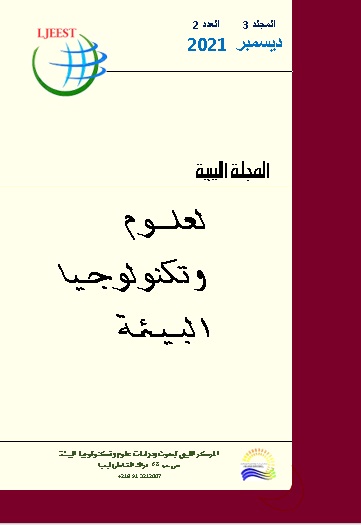متبقيات مبيدي السوبركل والفيرتميك في بعض خضار الصوبات.
DOI:
https://doi.org/10.63359/ytqd8s43الكلمات المفتاحية:
تقييم المخاطر، مبيدات الآفات، بقايا، الدفيئة، الخضرواتالملخص
تناولت الورقة تتبع وتقدير متبقيات مبيدي السوبركل 32% والفيرتميك 1.8% على ثلاثة أنواع مختلفة من الخضروات الصيفية (الباذنجان، الكوسة، الفلفل) والمزروعة في الصوبات الزراعية خلال فصل الشتاء. وتطبيق بعض معايير تقييم المخاطر الصحية (معدل الاستهلاك اليومي من المبيد DIR، ومؤشر المخاطر الصحية HIR) على المستهلكين في المناطق الجنوبية (اوباري، وادي الشاطئ، تراغن، وادي عتبة). النتائج أظهرت تجاوز تراكيز متبقيات مبيد السوبركل الحدود المسموح بها في الخضار المدروسة فيما عدا ثمار الكوسة، وكان أعلى تركيز في ثمار الباذنجان 4.71 ميكروجرام/جم يليه ثمار الفلفل 1.15 ميكروجرام/جم. أما تراكيز متبقيات مبيد الفيرتميك قد تعدت الحدود المسموح بها في جميع الخضار الصيفية المدروسة، حيث كانت الحصة الأعلى للباذنجان أيضا بتركيز 1.65 ميكروجرام/جم، ثم يلي ذلك الفلفل والكوسة بتركيز 1.22 ، 0.69 ميكروجرام/جم على التوالي. وكان أعلى معدل للاستهلاك اليومي لمبيد السوبركل (0.1325 جم/يوم) ومبيد الفيرتميك (0.0075 جم/يوم) في منطقة أوباري وخاصة في ثمار الباذنجان. كما كشفت النتائج أقتراب مؤشر المخاطر الصحية من الخطير (0.5) في منطقة الشاطئ، والخطير جداً (0.6) في منطقة أوباري عند تناول ثمار الكوسة حسب معايير منظمة الزراعة والغذاء. هذا وخلصت النتائج بأن الخطر يكمن في تراكم هذه المركبات داخل جسم الإنسان، لذا يجب تنبيه المستهلكين بذلك وتقليل استهلاك خضار الصوبات الشتوية أو منع تداول واستعمال هذه المبيدات الخطيرة، لتقليل أو منع وصولها لأكبر فئة من المستهلكين.
المراجع
الحلفي، مشتاق عبد المهدي (2005): "اثر المبيدات الحشرية في بيئة أهوار وانهار جنوب العراق" . مجلة وادي الرافدين ، 20(1) ، ص89-81.
الدوسري، صالح بن عبدالله ، السعيد، محمد بن حمزة (2003): " رصد بقايا المبيدات في الأغذية بالمملكة العربية السعودية " . جامعة الملك سعود - كلية علوم الأغذية والزراعة – قسم وقاية النبات .
السعيدي، محمد علي (2015): "متبقيات السيبركل (Cypermethrin) على أنواع من الخضار بالصوب منطقة وادي الشاطئ" . مجلة العلوم, جامعة مصراته، 1(1).
الكيلاني، آية عبدالقادر، السعيدي، محمد علي (2016): " تقصي مبيدي اللانيت والكونفيدور في بعض أنواع الخضار المتداولة في الأسواق المحلية بمنطقة وادي الشاطئ"، المؤتمر الثاني للعلوم والتكنولوجيا، في الفترة 16-17 ديسمبر 2019، براك الشاطيء، ليبيا، عدد خاص بالمؤتمر مجلة جامعة سبها.
النحال، ياسر (2014): " مبيدات محظورة ومقيدة ومسموحة تنشر الأمراض لسوء استخدامها من قبل المزارعين". مجلة حياة وسوق، السنة الثالثة ، العدد 139.
شعبان، عواد ونزار مصطفى الملاح (1993): " المبيدات" . جامعة الموصل . دار الكتب للطباعة والنشر، الموصل ، ص519.
عبدالحميد، زيدان هندي (2000): "هموم الإنسان والبيئة". دار كانزا قروب للنشر ، القاهرة ، مصر، ص506.
فارس، علي محمود ، عمران، الصادق سعيد، شلوف، فيصل مفتاح (2004): "الآثار الاقتصادية للاستخدام الخاطئ للكيماويات على الإنتاج الزراعي والبيئة في منطقة الجبل الأخضر– ليبيا". مجلة المختار للعلوم الإنسانية, العدد الثاني, 2004.
مظلاه، حيدره علي أحمد (2002): "مبيدات الحشرات وعلاقتها بتلوث البيئة – اليمن" . مجلة أسيوط للدراسات البيئية، العدد الثالث والعشرين .
Altman, J. (1993): “Impact of herbicides on plant diseases. In Ecology and Management of soil borne Plant Pathogens, Parker, C. A., A. D. rovira, K. J. moore, P.T.W. Wong, and J. F. ollmorgen (Editors)”. The american phytopathological society, st . paul, MN. 227-231.
Anwar W. A. (1997): “Biomarkers of Human Exposure to Pesticides”. Environmental Health Perspectives , 105: 801-806.
Baldwin, W.S. and LeBlanc, G.A. (1994): “Identification of multiple steroid hydroxylases in Daphnia magna and their modulation by xenobiotics. Environ”. Toxicol. Chem. 13: 1013-1021.
Belson M. , Kingsley B., and Holmes, A. (2007): “Risk Factors for Acute Leukemia in Children: A Review Centers for Disease Control and Prevention, National Center for Environmental Health, Division of Environmental Hazards and Health Effects, Health Studies Branch, Atlanta, Georgia, USA, Environmental Health Perspectives. 115(1)
Botwe, B. O.Ntow, W. J. Kederman, P. Drechsel, P. Derick,C. GijzenH.(2011): “Pesticide Residues Contamination of Vegetables and their Public Health Implications in Ghana”, Journal of Environmental Issues and Agriculture in Developing Countries, 3(2).
Brewer, S.K., Little, E.E., DeLonay, A.J., Beauvais, S.L. and Jones, S.B. (2001): “Behavioral dysfunctions correlate to altered physiology in rainbow trout (Oncorynchus mykiss) exposed to cholinesterase- inhibiting chemicals”. Arch. Environ.Contam. Toxicol. 40:70-76.
Burridge, L.E and Haya, K. (1997): “Lethality of pyrethrins to larvae and postlarvae of the American lobster (Homarus americanus)”. Ecotoxicol. Environ. Safety 38: 150-154.
Cengiz, E.I. and Ünlü, E. (2003): “Histopathology of gills in mosquitofish (Gambusia affinis) after long-term exposure to sublethal concentrations of malathion”. J. Environ. Sci. Health B: 38:581-589.
Chaudhry, R., Lall, S. B., Mishra, B. and Dhawan, B. (1998): “A foodborne outbreak of organophosphate poisoning”. BMJ 1998; 317(7153): 268-269.
Fossi, M.C.; Focardi, S.; Leonzio, C.; Gavilan, J.F.; Barra, R and Parra, O. (1995): “Use of biomarkers to evaluate effects of xenobiotic compounds in Biobio Basin (central chile)”. Bull. Environ. Contam. Toxicol., 55: 36-42.
Frank, - R; Broun, HE; Pitblado, - R(1991): “Resdues of urine insecticides and two fungicides in row and processed tomatoes Journal of Food – protection” . 1991, 54(13) : 41.
Frumkin, H. (2003): “Agent Orange and Cancer: An Overview for Clinicians” . 53 (4):245- 324.
Goedicke, HJ; Hermes, H; Wanger, R(1989): “Exposure to residues on plant Surfaces after the use of pesticides in the greenhouse Zeitschsift - fur – die – gessamte –” 35(9): 531-533.
Heidari, H. (2003): “Pesticides : Farmer field schools (FFS) slash pesticide useand exposure in Islamic Republic of Iran Agro-Chemicals Report” . 3(1): 23-26 .
Helfrich, L.A.; Weigriann, D.L.; Hipkins, P. and Stinson, E.R. (1996): “Pesticides and aquatic animals: A guide to reducing impacts on aquatic systems Virginia cooperative extension, Publication, Virginia.
Ishihara, A.; Nishiyama, N.; Sugiyama, S. and Yamauchi, K. (2003): “The effects of endocrine disrupting chemicals on thyroid hormone binding to Japanese quail transthyretin and thyroid hormone receptor”. Gen. Comp. Endocrinol. 134: 36-43.
Jain, RK ; paruthi, Ij; Gupta, Dc (1988): “Control of root Kont nematode (Meloidogyne javanica) in tomato Combianation with application of carbo furan at transplanting Indian” . Jouran of nematology 1988, 18(4):2, 340- 341 .
Khanjani, N. ; English, D. R. and Sim, M. R. (2006): “Pesticides and Breast Cancer in Rural Victoria, Australia”. Archives of Environmental Contamination and Toxicology . 50(3): 452-461.
Lee, W. J.; Blai,r A.; Hoppin, J. A.; Lubin, J. H.; Rusiecki, J. A.; Sandler D. P.; Dosemeci M. and Alavanja M. C. R. (2004): “Cancer Incidence Among Pesticide Applicators Exposed to Chlorpyrifos in the Agricultural Health Study”. Journal of the National Cancer Institute, 96 (23): 1781-1789.
Lveda, M. S. S.; Wiebe, J. J.; Honeyfield, D.C.; Rauschenberger, H. R.; Hinterkopf, J.P.; Johnson W E. and Gross1T. S. (2004). Organochlorine Pesticides and Thiamine in Eggs of Largemouth Bass and American Alligators and Their Relationship with Early Life-stage Mortality. Journal of Wildlife Diseases, 40(4), , pp. 782–786.
Munawar A, Hameed SW (2013) Quantification of Pesticide Residues in Vegetables by Different hromatographic Techniques. J. Chromatograph Separat Techniq 4: 200. doi:10.4172/2157-7064.1000200
Meinert, R.; Schuz, J.; Kaletsch, U.; Kaatsch, P. and Michaelis, J.(2000): “Leukemia and Non-Hodgkin's Lymphoma in Childhood and Exposure to Pesticides: Results of a Register-based Case-Control Study in Germany”. Am J Epidemiol . 151(7): 639-646.
Monge P. (2006): “Occupational exposure to pesticides and risk of leukemia among offspring in Costa Rica” . Thesis , Stockholm, Sweden.p:62.
Murphy, H., Sanusi, A., Dilts, R., Djajadisastra, M., Hirchhorn, N. and Yuliantiningsih, S.(1999): “Health effects of pesticide use among Indonesian farmers”. Part I: exposure and acute effects. J. Agromedicine. 6:61-85.
Pimentel, D. and Greiner, A,: (2002): “Environmental and socio-economic costs of pesticide use in D. pimentel (ed): Techniques for reducing pesticide use: environmental and economic benefits, chichester, UK, j.hon wiley and sons, 51-78.
Rahman, s . Rahman ,M . Hossain, S (2015): “Cypermethrin residue analysis offruit and soil samples in eggplant ecosystem in Bangladish”. The science publishers, lets.
Roberts, D. M.; Karunarathna, A ; Buckley, N. A.; Manuweera, G. M.H. ; Sheriff, R. V. and Eddleston, I. (2003): “ Influence of pesticide regulation on acute poisoning deaths in Sri Lanka Bull World Health Organ”. 81 (11) Genebra Nov.
Rusiecki, J. A.; Roos, A. D.; Lee, W. J., Dosemeci, M.; Lubin, J. H.; Hoppin, J. A.; Blair, A.; and Alavanja, M. C. R.(2004): “Cancer Incidence Among Pesticide Applicators Exposed to Atrazine in the Agricultural Health Study”. Journal of the National Cancer Institute, 96(18): 1375- 1382.
Sandler D. P. ; Coble J.; Thomas K.; and Blair A. (2004). Pesticides and lung Cancer Risk in the Agricultural Health Study Cohort. Am J Epidemiol;160 (9):876–885.
Simposon, W. and Schumans, H.(2002): “Recognition and Management of Acute Pesticide Poisoning” . American family physician. 65(8): 1599.
Stan , H. (1990): “Pesticides. cited .Gordon M.H. Principles and Applications of Gas Chromatography in Food Analysis, England”.
Tsafe, L, G. Hassan, D.M. Sahabi, Y. ALhassan, B. M. Bala (2012): “Evaluation of Heavy Metals Uptake and Risk Assessment of Vegetables Grown in Yargalma of Northern Nigeria ”. Journal Basic. Appl. Sci. Res. 2(2012): 6708 -6714.
WHO. (2006): “Pesticides and their application: For the control of vectors and pests of public health importance”. Sixth edition.
WHO/UNEP.(1989): “Public health impact of pesticides used agriculture, worled health organzation/united national environmntal programe, geneva”.
Zahm, S. H. and Ward, M. H. (1998): “Pesticides and Childhood Cancer”. Environmental Health Perspectives Supplements . 106(S3), June















